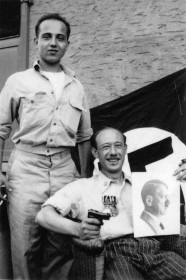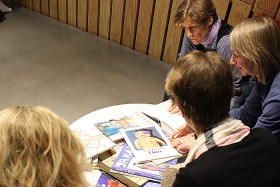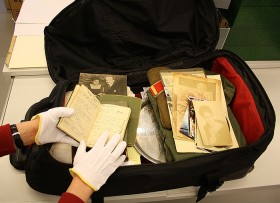Program Director Cilly Kugelmann on the Exhibition “NO COMPROMISES! The Art of Boris Lurie”

“As this image of Lurie with his brother-in-law Dino Russi from 1946 shows, the NO!art artists, in reclaiming the swastika symbol, robbed it of its symbolic value.” (Cilly Kugelmann)
Boris Lurie Art Foundation, New York
Our major retrospective dedicated to Boris Lurie opens 26 February 2016 (for more information see www.jmberlin.de/lurie/en). Blog editor Mirjam Bitter spoke with Cilly Kugelmann about the artist, his provocative work, and the possible impact today of the taboos that he broke throughout his career.
Mirjam Bitter: What is your view of Boris Lurie? What sort of a guy was he? What distinguished him as an artist?
Cilly Kugelmann: The man and the artist Boris Lurie was shaped by his experience of persecution and concentration camps under the Nazi regime. And yet, unlike other artists who faced similar experiences, I feel he cannot be described as a “Holocaust artist.” With the exception of some early drawings from 1946 and a few paintings from the late 1940s, he neither chronicled these events nor sought to interpret the Holocaust artistically in his work.
Then what role did the Holocaust play in Lurie’s work? → continue reading
An Interview with Barbara Rösch about “Recommended Reading on National Socialism and the Holocaust”

Members of the reading circle © Jewish Museum Berlin, photo: Christine Marth
A German-language brochure listing “Recommended Reading on National Socialism and the Holocaust” was recently made available for download from our website as a PDF. Over the last few years several museum employees read widely on the topic, shared their opinions and then made this selection. Dr. Barbara Rösch of our Education Department talked to me about what was involved. She is a member of the reading circle and also worked for a time at the Universities of Potsdam and Leipzig as an elementary school teacher trainer. In addition to her work at the Jewish Museum Berlin she is currently writing a book about everyday racism in elementary schools.
Dear Barbara, countless books about National Socialism and the Holocaust are available for children and young people. How did you go about making a selection?
Our work is oriented primarily to the needs of teachers, who regularly ask us to make recommendations and indeed seem almost to think that we must. We therefore bear in mind the so-called “classics” that are read in German classrooms as well as new publications, books written from a non-German perspective, and books that touch upon hitherto neglected themes, such as the hakhshara movement. → continue reading
The Last Signs of a Life in Germany Sold at Auction 75 Years Ago

Franziska Bogdanov, unpacking the suitcase from Arno Roland’s bequest
Jewish Museum Berlin CC-BY Katharina Erbe
The items in our archives have arrived here through the most various means: we have donations from German-Jewish emigrants from all over the world as well as gifts from their estates, donated to the museum after they have died by their children. We also receive some gifts from Germany, occasionally from people who aren’t themselves Jewish and yet some memorabilia from a Jewish friend or acquaintance was passed down through the generations in their family.
At the end of this last year we received a donation from the estate of a one-time Berliner who recently died in New Jersey (USA). It consisted of a large suitcase filled to the brim with documents, letters, photographs, and other objects. → continue reading


